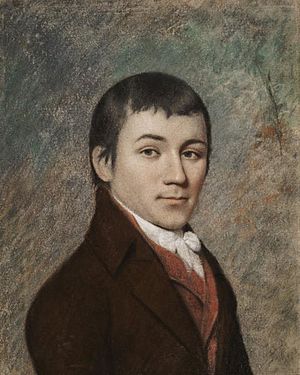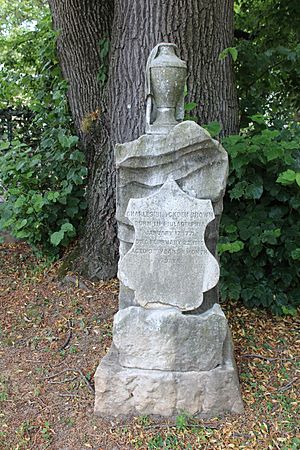Charles Brockden Brown facts for kids
Quick facts for kids
Charles Brockden Brown
|
|
|---|---|

Portrait by James Sharples (c. 1798)
|
|
| Born | January 17, 1771 Philadelphia, Pennsylvania |
| Died | February 22, 1810 Philadelphia, Pennsylvania |
| Occupation |
|
| Genre | Gothic fiction |
| Notable works |
|
| Signature | |
Charles Brockden Brown (born January 17, 1771 – died February 22, 1810) was an important American writer. He was a novelist, historian, and editor during the early years of the United States. Many experts consider him the most important American novelist before James Fenimore Cooper.
Brown is often studied as a key writer of the "early American novel." This refers to books written in the U.S. between 1789 and about 1820. He wrote many different kinds of things. These included novels, short stories, essays, and articles for magazines. He also wrote poetry and historical works. Because of all this, he is a very important person in American literature and culture from the 1790s and early 1800s. Some even call him the "Father of the American Novel." Brown was also a well-known thinker during the time of the French Revolution.
Contents
Biography
Early Life and Education
Charles Brockden Brown was born on January 17, 1771. He was the fourth of five brothers and had six sisters who lived. His family were Quaker merchants in Philadelphia. Quakers are a religious group known for their simple lifestyle and peaceful beliefs.
His father, Elijah Brown, worked with real estate. Charles's older brothers were involved in buying and selling goods from other countries. For a short time, Charles also worked with his brothers' trading company. His family's background in business often showed up in his writings. He explored how trade and money changed society.
Brown's family wanted him to become a lawyer. He studied law for six years in Philadelphia. But in 1793, he decided to stop his law studies. He wanted to become a writer instead.
Starting His Writing Career
After leaving law, Brown joined a group of young, smart people in New York City. They called themselves the Friendly Club. This group included his close friend, Dr. Elihu Hubbard Smith, and William Dunlap. They also had female friends and family who enjoyed talking about culture and politics. This group helped Brown start his writing career.
Throughout the 1790s, Brown worked on many writing projects. Some of them were never finished. He often used his letters to friends to try out new story ideas. He published his first essays in the late 1780s. But he didn't publish much more until 1798.
By 1798, Brown began publishing his most famous novels. His writing was shaped by the ideas of British writers. These included Mary Wollstonecraft, William Godwin, and Thomas Holcroft. These writers believed in progressive ideas, like more rights for people. Brown was influenced by them, and he also influenced later writers. For example, Mary Shelley, who wrote Frankenstein; or, The Modern Prometheus, read Brown's novels.
His Novels
Between 1798 and 1801, Brown published a book called Alcuin (1798). This book was a conversation about women's rights, inspired by Mary Wollstonecraft. He also published seven novels during this time. He wrote another novel, but it was lost and never published.
Besides writing novels, Brown also became an editor. He helped publish and write for magazines like The Monthly Magazine and American Review. He also wrote many short stories and articles for other Philadelphia magazines.
Brown's novels are often called Gothic fiction. This type of fiction usually involves mystery, suspense, and sometimes supernatural events. However, Brown's Gothic stories were different from others. He mixed them with ideas from the Revolutionary era. He also added scientific and medical knowledge from the late 1700s.
His novels often used ideas from writers like Wollstonecraft and Godwin. He also included parts of German Gothic stories and sentimental novels. He even used elements from women's domestic novels and captivity narratives. Brown's plots often featured themes like sleepwalking and strong religious beliefs. He used medical writings from his time, like those by Erasmus Darwin, to create these ideas.
Of his seven novels, the first four are the most famous. These are Wieland, Ormond, Edgar Huntly, and Arthur Mervyn. They are known for their exciting violence, strong emotions, and deep ideas. Because of this, they are often called his "Gothic" novels. His other novels, Stephen Calvert, Clara Howard, and Jane Talbot, were less known for a long time. But experts now see how all his novels connect and share similar themes.
Combining History and Fiction
Brown had a clear plan for his novels. He wrote essays like "Walstein's School of History" (1799) to explain it. He believed his novels should mix fiction and history. He would place ordinary people, like his characters Arthur Mervyn or Edgar Huntly, into real historical events. Examples include the Yellow Fever outbreak in Philadelphia in 1793. Another example is the violence between settlers and Native Americans on the Pennsylvania frontier.
By doing this, Brown wanted to teach his readers. He wanted to show them how to behave well. He also wanted to explain the historical reasons behind people's actions. In short, Brown used his stories to share progressive ideas. He wanted to be part of the important discussions of his time. For example, his support for feminism came from his Quaker background and his belief in the ideals of the Revolutionary era.
Brown was not just copying other writers. He was an independent thinker who improved on their ideas. He believed, like the British writers, that society shapes people. He also thought literature could spread progressive ideas. He shared with Godwin the goal of mixing history and fiction. This created a unique style meant to make people think and act.
Brown also added new ideas to his stories. He focused on the world of business and money. This was a topic that other writers didn't emphasize as much. But it became very important after the American Revolution. He also explored ideas about personal identity, like gender. He connected these to bigger issues of power in the new society of the early 1800s. Brown often showed that his novels explored relationships between men and women, and also economic issues.
Later Life and Writings

After 1801, Brown continued to write a lot. He wrote several important political pamphlets. These argued for the United States to buy the Louisiana Territory. He also wrote against the Embargo Act of 1807, which stopped American ships from trading with other countries.
He also edited and wrote for two more magazines. These included The Literary Magazine and American Register (1803–1806). This magazine covered many topics, from geography and medicine to history and art. He also edited The American Register and General Repository of History, Politics, and Science (1807–09). This magazine included his long historical account of Napoleon's influence on world politics.
Brown kept writing fiction and trying new types of writing. He wrote a group of historical stories called Historical Sketches. These were written between 1803 and 1807 but published after he died. These stories show how Brown explored the mix of fiction and history. He was writing at a time after famous historians like David Hume and before popular historical novelists like Walter Scott. He also wrote for other Philadelphia newspapers and magazines.
Brown also stayed connected with people and groups working for social change in Philadelphia. He planned to write a "History of Slavery" using records from the Pennsylvania Abolition Society. He was also suggested as a good writer for a history of prison reform in Philadelphia. Brown was very interested in these reform efforts. He often visited new hospitals and prisons, like Philadelphia's Walnut Street Prison.
Brown died from tuberculosis in Philadelphia on February 22, 1810. He was only 39 years old. He was buried at the Arch Street Friends Meeting House Burial Ground. A memorial stone was placed in his honor at Laurel Hill Cemetery in Philadelphia.
Brown's Novels
- Sky-Walk; or, The Man Unknown to Himself (finished by March 1798, but lost and never published)
- Wieland; or, the Transformation (September 1798)
- Ormond; or, the Secret Witness (January 1799)
- Arthur Mervyn; or, Memoirs of the Year 1793 (May 1799)
- Edgar Huntly; or, Memoirs of a Sleep-Walker (August 1799)
- Memoirs of Stephen Calvert (published in parts from June 1799 to June 1800)
- Arthur Mervyn; or, Memoirs of the Year 1793, Second Part (September 1800)
- Clara Howard; In a Series of Letters (June 1801)
- Jane Talbot; A Novel (December 1801)
See also
 In Spanish: Charles Brockden Brown para niños
In Spanish: Charles Brockden Brown para niños
- List of Minerva Press authors
- Minerva Press


